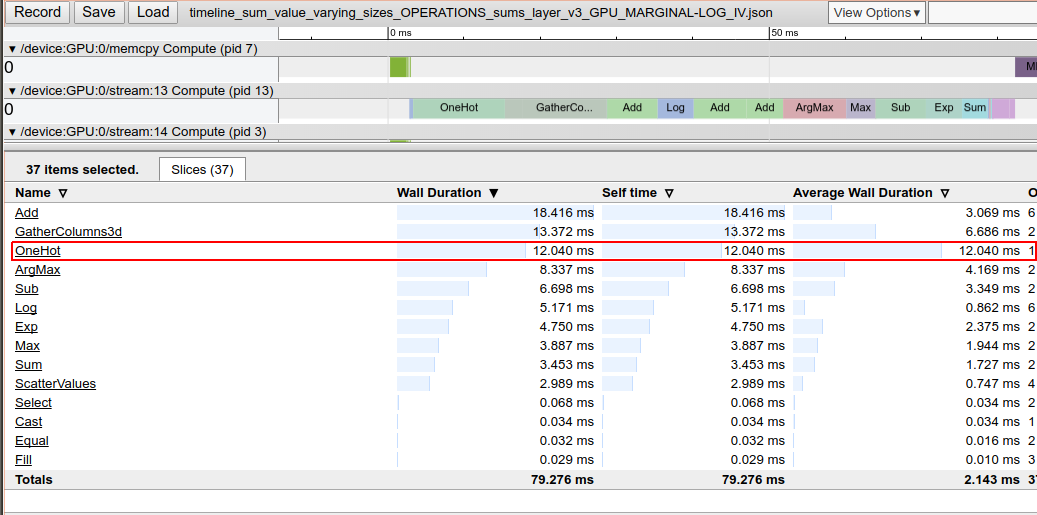-
Notifications
You must be signed in to change notification settings - Fork 3
LIP0008
| LIP | 8 |
|---|---|
| Title | Revising the IV value construction |
| Author | J. van de Wolfshaar |
| Status | Draft |
| Type | Standard |
| Discussion | Issue #38 |
| PR | |
| Created | Feb 22, 2018 |
As became apparent during several performance tests, the value of IVs nodes can take a considerable
amount of wall time compared to other parts of graph. In this LIP, we will propose an alternative
implementation of the sub graph that computes the value of the IVs from the sparse input representation.
At this point, the value of an IV is computed as follows:
def _compute_value(self):
"""Assemble the TF operations computing the output value of the node
for a normal upwards pass.
This function converts the integer inputs to indicators.
Returns:
Tensor: A tensor of shape ``[None, num_vars*num_vals]``, where the
first dimension corresponds to the batch size.
"""
# The output type has to be conf.dtype otherwise MatMul will
# complain about being unable to mix types
oh = tf.one_hot(self._feed, self._num_vals, dtype=conf.dtype)
# Detect negative input values and convert them to all IVs equal to 1
neg = tf.expand_dims(tf.cast(tf.less(self._feed, 0), dtype=conf.dtype), dim=-1)
oh = tf.add(oh, neg)
# Reshape
return tf.reshape(oh, [-1, self._num_vars * self._num_vals])And its log value (in VarNode) is defined as:
def _compute_log_value(self):
"""Assemble TF operations computing the marginal log value of this node.
Returns:
Tensor: A tensor of shape ``[None, out_size]``, where the first
dimension corresponds to the batch size.
"""
return tf.log(self._compute_value())When using IVs with a large number of sums, this part of the code can become one of the most
expensive to compute as can be seen in the image below (taken from a performance test profiling of a
SumsLayer):

We could actually reduce the graph size and simplify the implementation of the _compute_value by
storing every possible row of the resulting tensor in advance and then gathering the correct
indices. If our _feed is actually a sparse representation of IVs then we might just use the
value of _feed as row indices of an identity matrix as large as self._num_vals. We could even
reuse a single identity matrix for any IV in our graph. This would then be an identity matrix of
the maximum self._num_vals size over all IVs instances. The value of the IV can then be found
using tf.gather on the identity matrix.
Of course, we need to take care of the inputs with the value -1. We could realize that by adding
another row to the top of the matrix and the adding 1 to the values before calling tf.gather.
Lastly, for the _compute_log_value we should predefine the log of the matrix described above, so
that we don't need to perform tf.log afterwards and simply gather instead.
The overview below displays the performance differences when using gather vs. one_hot. There is
a marginal speed up in the case of the gather alternatives. The gather_v1 implementation uses
a tf.constant to store the identity matrix and the gather_v2 implementation uses a tf.Variable
to store the matrix. Finally, the gather_v3 uses a single matrix to store identity matrix for
all IVs in the graph (in this case we model the value computation of 10 IV nodes with a
batch size of 60000 and 200 values each).
#-----------------------#
IVs value
#-----------------------#
CPU op dt: size setup_time first_run_time rest_run_time correct
GPU op dt: size setup_time first_run_time rest_run_time correct
gather_v1 int32: 54 19.03 5.77 1.00 True
gather_v2 int32: 69 26.48 3.65 1.06 True
gather_v3 int32: 34 13.74 5.41 0.96 True
one_hot int32: 64 21.73 13.52 1.26 True
#-----------------------#
IVs log value
#-----------------------#
CPU op dt: size setup_time first_run_time rest_run_time correct
GPU op dt: size setup_time first_run_time rest_run_time correct
gather_v1 int32: 59 29.34 7.78 1.04 True
gather_v2 int32: 74 34.57 4.50 1.08 True
gather_v3 int32: 35 15.40 5.67 1.06 True
one_hot int32: 69 22.38 6.47 1.22 True
In principle, constructing a dense one-hot representation should still be faster than simply
gathering from an identity matrix as this requires full memory copying per row, instead of just
initializing memory at 0 and inserting 1 at a limited set of rows.
This suggests that the TF implementation is not implemented efficiently. Another LIP will propose
a custom TF operation for IVs that deals with the dense representation.